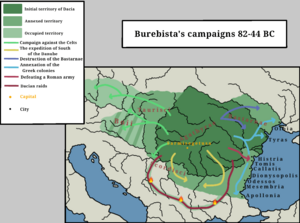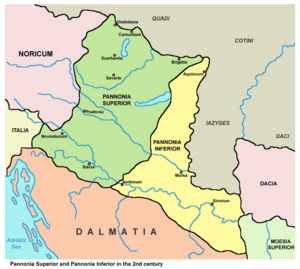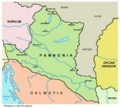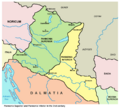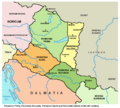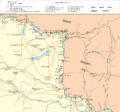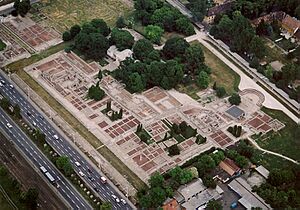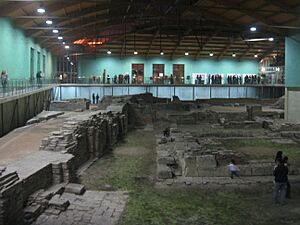Pannonia facts for kids
Quick facts for kids Provincia Pannonia |
|
|---|---|
| 8/9 – 433 AD | |
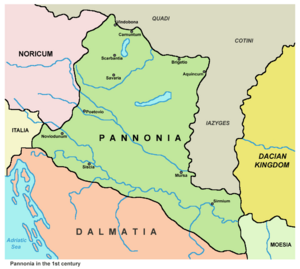 Province of Pannonia in the first century AD |
|
| Capital | Carnuntum, Sirmium, Savaria, Aquincum, Poetovio or Vindobona |
| Demonym | Pannonian |
| Historical era | Classical antiquity |
|
• Established via separation from Illyricum
|
8/9 |
|
• The Western Roman Empire officially cedes Pannonia to the Hunnic Empire
|
433 AD |
Pannonia was an important province of the Roman Empire. It was located north and east of the Danube River. To the west, it bordered Noricum and northern Italy. To the south, it bordered Dalmatia and northern Moesia.
Today, the land that was once Pannonia covers parts of western Hungary, western Slovakia, eastern Austria, northern Croatia, north-western Serbia, northern Slovenia, and northern Bosnia and Herzegovina.
Contents
Early History of Pannonia
In the early Iron Age, a group of Illyrian tribes called the Pannonians lived in this area. The name "Pannonia" comes from them. Later, the Celts arrived and settled there. They built many villages, and some of these grew into important towns called oppida. These tribes even made their own coins.
Over time, different groups became powerful. The Scordisci and Dardani were strong tribes who often fought each other. The Dardani had close ties with Rome. Later, the Dacians became very strong. Their king, Burebista, defeated many tribes in the region. However, after Burebista died around 44 BC, the Dacian kingdom broke apart. This left the area open for Rome to expand.
Rome Takes Control
The Pannonians got involved in conflicts because they supported the Dalmatae tribe against Rome. In 35 BC, the Roman leader Octavian (who later became Emperor Augustus) led a campaign against the Pannonians. He captured a key town called Siscia (modern Sisak, Croatia). This helped Rome gain control over a large part of the Sava River valley.
Later, in 15 BC, Tiberius (who would also become emperor) defeated the Scordisci. This was part of Rome's plan to reach the Danube River and make it a border. This series of events is sometimes called the Bellum Pannonicum, or Pannonian War.
The Pannonians rebelled again in 14 BC and 13 BC. After some fighting, Tiberius took charge of the campaign. He won in 11 BC. The Roman province of Illyricum was then created between the Sava River and the Adriatic Sea.
Another big uprising happened in 6 AD. This was known as the Bellum Batonianum and lasted for three years. The Breuci and Daesitiates tribes led this revolt. They tried to invade Italy and Macedonia but failed. The Romans, led by Tiberius and other generals like Germanicus, eventually put down the rebellion. By 9 AD, the Pannonians were defeated.
Emperor Augustus later wrote that Tiberius had brought the Pannonian peoples under Roman rule. He said that the borders of Illyricum were extended all the way to the Danube River.
Pannonia as a Roman Province
Setting Up Roman Rule
After the big revolt, the Roman province of Illyricum was split into two parts around 8 or 9 AD. These were Dalmatia and Pannonia. The Pannonian people were very tired from the wars. Rome conscripted many young Pannonian men into their armies and sent them to other provinces.
Emperor Tiberius (who ruled from 17 to 37 AD) helped develop Pannonia. He founded new towns and improved the road network. However, it was hard to get Roman soldiers to settle there because the land was not great for farming.
Later, Emperor Claudius (who ruled from 41 to 54 AD) finished taking control of Pannonia. He also started building the limes, which were border defenses. Roman ways of life slowly became established in the province. Around 50 AD, the nomadic Sarmatian people, called the Iazyges, settled in the area between the Danube and Tisza rivers. They acted as a helpful barrier against the Dacians.
Under the Flavian Emperors
During the time of the Flavian emperors (69-96 AD), Rome invested a lot in building the limes. Legions (large Roman army units) were moved to the border to protect the empire. This also stopped them from getting involved in Roman politics. Roman money became common in the region, showing that Roman culture was taking hold.
Emperor Domitian (81-96 AD) faced expensive wars with barbarian tribes. The Dacians, led by Decebalus, attacked the province of Moesia. Rome fought back, but the wars were tough. Domitian eventually made peace with Decebalus. He also had problems with the Marcomanni and Quadi tribes who refused to be Roman allies.
Under the Antonine Emperors
Between 103 and 107 AD, Emperor Trajan (98-117 AD) divided Pannonia into two smaller provinces: Pannonia Inferior and Pannonia Superior. This helped Rome manage the different Germanic and Sarmatian tribes better. Pannonia Superior had more cities and three legions, while Pannonia Inferior was more of a border zone with one legion.
The creation of Roman Dacia (another Roman province) greatly affected Pannonia. The Iazyges tribe allied with Rome during Trajan's Dacian Wars. After Trajan's death, the Iazyges and Roxolani tribes attacked again in 117 AD. Emperor Hadrian (117-138 AD) sent his general, Marcius Turbo, to defeat them. Peace was made in 119 AD.
Later, during the reign of Marcus Aurelius (161-180 AD), Pannonia faced many barbarian attacks. Large groups of people from northern and eastern Europe, including the Goths, moved around. This put pressure on Rome's allies. The first major attack came in the winter of 166-167 AD from the Lombards and Ubii tribes.
In 168 AD, Marcus Aurelius and his co-emperor Lucius Verus set up their base in Aquileia. The Marcomanni and Quadi tribes broke through the border and attacked Roman towns. This was a very difficult time, made worse by a terrible plague. The Romans fought hard, suffering many losses. They eventually forced the Quadi and Marcomanni to surrender.
The war started again in 177 AD. Marcus Aurelius and his son Commodus came to Pannonia. A decisive campaign in 179 AD convinced the Iazyges to make peace. Rome occupied the lands of the Danubian Germans. Marcus Aurelius had plans to create two new provinces, but he died in 180 AD. Commodus then returned to the old system of client states. The wars had caused huge destruction and loss of life in Pannonia.
Commodus worked to strengthen the limes with new forts. Smaller raids continued, leading to more Roman campaigns across the Danube.
Under the Severan Emperors
During the time of the Severan emperors (193-235 AD), Pannonia was mostly peaceful. Emperor Septimius Severus (193-211 AD) made agreements with the barbarian tribes before he became emperor. The Pannonian military was very important to the Severan rulers.
In 202 AD, the imperial family visited Pannonia. During their visit and throughout Severus's rule, the province benefited greatly. Roads were repaired, new buildings were constructed, military camps were improved, and cities were protected with walls.
How Pannonia Was Governed
Pannonia was first divided into two parts:
- Pannonia Superior: This was governed by a high-ranking official and had three legions.
- Pannonia Inferior: This was governed by a lower-ranking official and had one legion. Later, it also came under a high-ranking official.
Under Emperor Diocletian (who ruled from 284 to 305 AD), Pannonia was divided into four smaller parts:
- Pannonia Prima (northwest)
- Pannonia Valeria (northeast)
- Pannonia Savia (southwest)
- Pannonia Secunda (southeast)
Diocletian also moved parts of modern Slovenia out of Pannonia. Later, Emperor Constantine I (who ruled from 306 to 337 AD) expanded Roman Pannonia to the east. He added plains in what is now eastern Hungary, northern Serbia, and western Romania. He also created new border defenses called the Devil's Dykes.
In the 4th and 5th centuries, a larger Roman administrative area called the Diocese of Pannonia was created. It included all four Pannonian provinces, plus Dalmatia and Noricum.
Loss of Pannonia
In the 4th century, the Romans strengthened their defenses in Pannonia. They also moved some barbarian tribes to the border regions. Despite a big Roman victory over the Sarmatians in 358 AD, raids continued.
In 401 AD, the Visigoths fled to Pannonia to escape the Huns. In 433 AD, Rome officially gave Pannonia to Attila and the Hunnic Empire. This was done to get Attila's help against other tribes attacking Roman Gaul.
After Roman Rule
After the Hunnic Empire collapsed in 454 AD, many Ostrogoths were settled in Pannonia by Emperor Marcian. They were allies of the Romans.
The Eastern Roman Empire (also known as the Byzantine Empire) controlled parts of southern Pannonia in the 6th century. They briefly brought back a province called Pannonia, but it was only a small part of the original area.
Later, the Avars invaded in the 560s, followed by the Slavs. The Slavs had settled there earlier but became independent in the 7th century. In the 790s, the Franks invaded and used the name "Pannonia" for their new border area, the March of Pannonia. The term Pannonia was also used for Slavic groups, like the Lower Pannonia, which was a vassal state of the Frankish Empire.
Cities and Forts
Most of the large towns in Pannonia were built by the Romans. Native settlements were usually villages. Here are some of the important cities and towns:
Now in Austria:
- Carnuntum (Petronell, Bad Deutsch-Altenburg)
- Vindobona (Vienna)
Now in Bosnia and Herzegovina:
- Saldae (Brčko)
- Serbinum or Servitium (Gradiška)
- Castrum and Canabea (Doboj)
Now in Croatia:
- Ad Novas (Zmajevac)
- Andautonia (Ščitarjevo)
- Aqua Viva (Petrijanec)
- Aquae Balisae (Daruvar)
- Certissa (Đakovo)
- Cibalae (Vinkovci)
- Cornacum (Sotin)
- Cuccium (Ilok)
- Halicanum (Sveti Martin na Muri)
- Iovia or Iovia Botivo (Ludbreg)
- Marsonia (Slavonski Brod)
- Mursa (Osijek)
- Siscia (Sisak)
- Teutoburgium (Dalj)
Now in Hungary:
- Ad Flexum (Mosonmagyaróvár)
- Ad Mures (Ács)
- Ad Statuas (Vaspuszta)
- Ad Statuas (Várdomb)
- Alisca (Szekszárd)
- Alta Ripa (Tolna)
- Aquincum (Óbuda, Budapest)
- Arrabona (Győr)
- Brigetio (Szőny)
- Caesariana (Baláca)
- Campona (Nagytétény)
- Cirpi (Dunabogdány)
- Contra-Aquincum (Budapest)
- Contra Constantiam (Dunakeszi)
- Gorsium-Herculia (Tác)
- Intercisa (Dunaújváros)
- Iovia (Szakcs)
- Lugio (Dunaszekcső)
- Lussonium (Dunakömlőd)
- Matrica (Százhalombatta)
- Morgentianae (Tüskevár (?))
- Mursella (Mórichida)
- Quadrata (Lébény)
- Sala (Zalalövő)
- Savaria (Szombathely)
- Scarbantia (Sopron)
- Solva (Esztergom)
- Sopianae (Pécs)
- Ulcisia Castra (Szentendre)
- Valcum (Fenékpuszta)
Now in Serbia:
- Acumincum (Stari Slankamen)
- Ad Herculae (Čortanovci)
- Bassianae (Donji Petrovci)
- Bononia (Banoštor)
- Burgenae (Novi Banovci)
- Cusum (Petrovaradin)
- Graio (Sremska Rača)
- Onagrinum (Begeč)
- Rittium (Surduk)
- Sirmium (Sremska Mitrovica)
- Taurunum (Zemun)
Now in Slovakia:
- Gerulata (Rusovce)
Now in Slovenia:
- Celeia (Celje)
- Neviodunum (Drnovo)
- Poetovio (Ptuj)
Economy in Pannonia
Pannonia was a productive region, especially after large forests were cleared. Timber was an important export. The main crops were oats and barley, which people used to brew a type of beer called sabaea. Grapevines and olive trees were not grown much. Pannonia was also known for its hunting dogs. Although ancient texts don't mention it, the region likely had iron and silver mines.
Slavery was not as common in Pannonia as in older Roman provinces. Wealthy civilians had slaves for housework, and soldiers who received land used slaves to farm it. Slaves also worked in workshops, especially in western cities. In Aquincum, slaves were often freed after a short time.
Religion in Pannonia
Pannonia had temples for Roman gods like Jupiter, Juno, and Minerva. There were also places of worship for old Celtic gods. In Aquincum, there was a sanctuary for a mother goddess. The worship of the emperor was also practiced. In addition, Judaism and eastern mystery cults (like those for Mithra, Isis, Anubis, and Serapis) were present.
Christianity began to spread in Pannonia in the 2nd century. Its popularity continued even during the big persecutions in the late 3rd century. In the 4th century, Christian churches and burial chapels were built. We know of the Church of Saint Quirinus in Savaria and many early Christian sites in other cities.
Legacy
The ancient name Pannonia is still used today in the term Pannonian plain, which refers to the large flat area in Central Europe.
See also
- Pannonian plain
- Roman provinces
- Diocese of Pannonia
- Pannonian Latin


